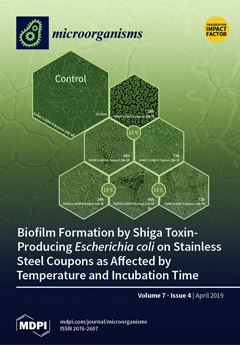Despite the essential role of
Bifidobacterium in health-promoting gut bacteria in humans, little is known about their functions in wild animals, especially non-human primates. It is difficult to determine in vivo the function of Bifidobacterium in wild animals due to the limited accessibility
[...] Read more.
Despite the essential role of
Bifidobacterium in health-promoting gut bacteria in humans, little is known about their functions in wild animals, especially non-human primates. It is difficult to determine in vivo the function of Bifidobacterium in wild animals due to the limited accessibility of studying target animals in natural conditions. However, the genomic characteristics of
Bifidobacterium obtained from the feces of wild animals can provide insight into their functionality in the gut. Here, we analyzed the whole genomes of 12
B. moukalabense strains isolated from seven feces samples of wild western lowland gorillas (
Gorilla gorilla gorilla), three samples of wild central chimpanzees (
Pan troglodytes troglodytes) and two samples of wild forest elephants (
Loxodonta cyclotis) in Moukalaba-Doudou National Park, Gabon. In addition, we analyzed the fecal bacterial communities of six wild western lowland gorillas by meta 16S rRNA gene analyses with next generation sequencing. Although the abundance of the genus
Bifidobacterium was as low as 0.2% in the total reads, a whole genome analysis of
B. moukalabense suggested its contribution digestion of food and nutrition of frugivore/folivore animals. Specifically, the whole genome analysis indicated the involvement of
B. moukalabense in hemicellulose degradation for short chain fatty acid production and nucleic acid utilization as nitrogen resources. In comparison with human-associated
Bifidobacterium spp., genes for carbohydrate transport and metabolism are not conserved in these wild species. In particular the glycosidases, which are found in all 12 strains of
B. moukalabense, were variably detected, or not detected, in human-associated species.
Full article






